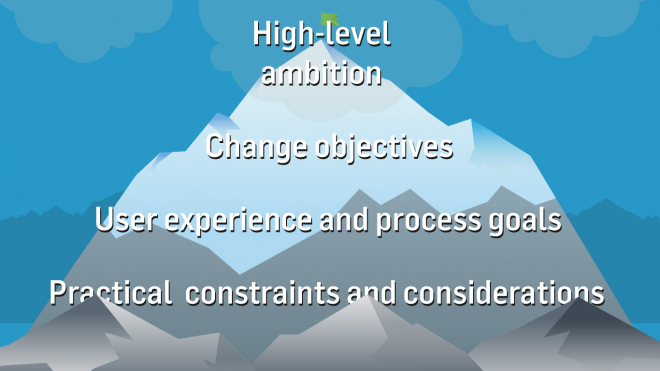Four levels of Goals and Objectives
Part one in a series of posts on our development proces
A large part of our work revolves around designing custom-made solutions that support learning in large organisations. In some cases, we design modules for internal academies. In other cases, we design materials and processes for workshops to be held at large meetings. Our solutions range from simple workshop concepts and tools to full-blown serious games.
In all cases, the work really starts with defining what our solution is supposed to achieve.
We try to be fairly methodical in our approach. Otherwise, goals or ambitions risk remaining unsaid until a time where they might be difficult to integrate.
Here are four levels we work our way through in order to get a good start in our design process:

Define high-level ambitions
Both the client and the designer should know how the solution is supposed to support the strategic ambitions of the the organisation on a high level.
No matter if the solution is about learning, creating ideas or making decisions,you have to think about how it can reflect the overall ambitions of the organisation. It is important that the solution supports and aligns with the strategic focus of the organisation and that it is integrated with other relevant activities that are running either before, after or in parallel.
In the best cases, the solution must feed into and support the high-level ambitions – but in some cases it is more a matter of not interfering too much.
Identify change objectives
If the planned solution is about learning, it always pays off to identify a list of learning objectives. It should be as clear as possible what the participants are to take away from the session.
Learning can happen on many levels, and for each learning objective it is important to distinguish between if the participants should just gain awareness about a topic, a more in-depth knowledge of the topic, or if they should achieve mastery of a certain task or process. This will define the design of the solution.
It is a good idea to prioritise this list. The most important learning objectives should be embedded into the very core of the design, and if the participants are supposed to achieve a high degree of learning (e.g. mastery), you need to allocate time accordingly.
Try and think beyond learning. Do this by asking the question; “what do you want to change?” and not just “what do you want to teach?”.
In broad terms, change can happen at three levels; knowledge, attitude/mindset and behaviour. Focussing on the change, and not just the learning, helps clarify change objectives of a deeper kind.
For example, if a headquarter function wants to train affiliates in managing external stakeholders, it should think about how it wants the affiliates to manage these relations afterwards and what they should get out it. E.g. does headquarters want the affiliates to use a certain set of tools or tactics in order to standardise how different affiliates react to a certain issue across countries?
Discuss experience objectives
The learning and change objectives will have great influence on both the process design and the content, but it is also fruitful to be explicit about what is expected of the process in general.
For example, should the process be fun and energising? Is it important that the participants network and get to know each other? Does the design need to have a realistic and life-like feel, or are the participants comfortable with engaging in more abstract exercises?
In many cases, the client may have certain tacit expectations, and some of these may even be in conflict with each other and with some of the learning objectives.
Maybe the most fun process is not realised through creating the most realistic scenario? Or maybe communication of in-depth knowledge is difficult to do in a fast-paced energising way?
If some compromises are to be made, this is best done in an open dialogue. And before the solution is designed.
Clarify practical constraints
Last, but not least, it is important to clarify all practical constraints.
This may be as tangible and obvious as time and place, the maximum number of participants, the expected duration of workshops, venue size and facilities.
In many cases, the client is very knowledgeable about these aspects, especially regarding the first run. It is a good idea however, to plan a little further and discuss if the materials should be made in a way that can support repeating usages.
For example, if materials should be easy to send or travel with, or if some components should be easy to customise for other use settings, etc.
Also, the client’s initial assumptions on the practical situation may be challenged as learning objectives are defined or the solution start to evolve.
For example, if the learning objectives are very complex, you may need more run-time, you may need extra breakout rooms to facilitate a noisy dialogue or it might be a good idea to have the participants make themselves familiar with some of the materials before the planned session to cut down on reading time.
With the goals and objectives in place it is time to start diving into the subject matter. You can read about our approach to research in the next post in the series; Bridging the knowledge gap.